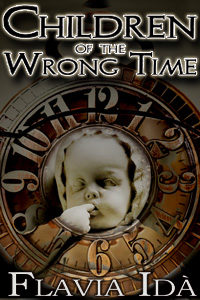

Flavia's Books
Mercy

After years of watching innocent people suffer, a psychiatric nurse makes it her mission to help the most hopeless of her patients — in a way no one will ever suspect.
Children of the Wrong Time

“Would you say you were loved by the right people at the right time in the right way and for the right reasons?”
Michael Holmes and Nora Savins stepped into the ornate atrium of the Department of Vital Privileges and looked up at the life-size marble statue of the Founding Father, a smiling young man who held in his hand an ancient movie script rolled into a scroll.
“Keanu Reeves,” Michael said reverentially, “with his quote from Parenthood: You need a license to drive, you need a license to fish, you need a license to own a dog, but they will let any moron be a parent.” And under the inscription he read the First Law of the Republic: “Never Again Any Moron.”
The Names of Heaven
 In 1511 a Spanish ship en route from the island of Hispaniola sank off the coast of Yucatan near the town of Tulum. The survivors were captured by the Maya; these were the first white men ever to set foot on the mainland of the American continent, and the first white men the Maya had ever seen. Among the castaways was Gonzalo Guerrero, a sailor from Palos.
After he was captured, he lived among the Maya as a slave for three years. He then escaped from his master and sought the protection of Lord Nachancan, ruler of Chetumal in Belize, who made him a free man. Gifted with a fine military mind, Gonzalo quickly rose to become Nachancan’s war captain; he married Nachancan’s sister and had three children with her. This was the first European-American family; it was the founding of the Mestizo race, and it changed the face of the New World.
In 1517 the conquistador Hernando Cortez came to bring Gonzalo back to the Spaniards, offering him a position of high power among them. The decision Gonzalo took then was the only one ever taken by a white man in the conquest of the Americas, and it made him a hero.
In 1511 a Spanish ship en route from the island of Hispaniola sank off the coast of Yucatan near the town of Tulum. The survivors were captured by the Maya; these were the first white men ever to set foot on the mainland of the American continent, and the first white men the Maya had ever seen. Among the castaways was Gonzalo Guerrero, a sailor from Palos.
After he was captured, he lived among the Maya as a slave for three years. He then escaped from his master and sought the protection of Lord Nachancan, ruler of Chetumal in Belize, who made him a free man. Gifted with a fine military mind, Gonzalo quickly rose to become Nachancan’s war captain; he married Nachancan’s sister and had three children with her. This was the first European-American family; it was the founding of the Mestizo race, and it changed the face of the New World.
In 1517 the conquistador Hernando Cortez came to bring Gonzalo back to the Spaniards, offering him a position of high power among them. The decision Gonzalo took then was the only one ever taken by a white man in the conquest of the Americas, and it made him a hero.
The Iron and The Loom
 The year is 1136, the place Tropèa, a walled sea town in Southern Italy during the Norman domination.
Kallyna d’Àrgira, a master of the arts of the loom who can turn the world into silk thread, is pledged in marriage by her father to Raimo Trani, a man she hates. After a sudden tragedy leaves her at Raimo’s mercy, into her life comes Dàlibor d’Hancourt, the Norman knight sent by King Roger of Hauteville to be the new governor of Tropèa, a man who, like her, is burdened by a life he did not choose. Their opposite stations—Kallyna the daughter of a fisherman, Dàlibor the son of a foreign lord—pit them at first against each other.
When Kallyna’s talent attracts the unwelcome attention of the heir to Roger’s throne, who can destroy them both, the common threat will draw them together, with a bond that defies all distinctions, into the time of iron that saw the founding of the greatest kingdom in Italy.
The year is 1136, the place Tropèa, a walled sea town in Southern Italy during the Norman domination.
Kallyna d’Àrgira, a master of the arts of the loom who can turn the world into silk thread, is pledged in marriage by her father to Raimo Trani, a man she hates. After a sudden tragedy leaves her at Raimo’s mercy, into her life comes Dàlibor d’Hancourt, the Norman knight sent by King Roger of Hauteville to be the new governor of Tropèa, a man who, like her, is burdened by a life he did not choose. Their opposite stations—Kallyna the daughter of a fisherman, Dàlibor the son of a foreign lord—pit them at first against each other.
When Kallyna’s talent attracts the unwelcome attention of the heir to Roger’s throne, who can destroy them both, the common threat will draw them together, with a bond that defies all distinctions, into the time of iron that saw the founding of the greatest kingdom in Italy.
Il ferro e il telaio
 Siamo a Tropea nell’anno 1136, durante la dominazione normanna di Re Ruggero II d’Altavilla.
Kallyna d’Àrgira, maestra del telaio la cui arte sa trasformare il mondo in filo di seta, è promessa in matrimonio dal padre a Raimo Trani, un uomo che lei detesta. Dopo che un’improvvisa tragedia la lascia in balìa di Raimo, la sua esistenza s’intreccia con quella di Dàlibor d’Hancourt, governatore normanno di Tropea, che come lei è oppresso da una vita non scelta. Le loro condizioni sociali—Kallyna figlia di pescatore, Dàlibor figlio di signore straniero—dapprima oppongono l’una contro l’altro.
Quando il talento di Kallyna attrae l’attenzione sgradita dell’erede al trono di Ruggero, il quale può distruggerli entrambi, la minaccia comune li unirà in un amore che sfida ogni distinzione, sullo sfondo dell’epoca di ferro che vide nascere il più grande regno d’Italia.
Siamo a Tropea nell’anno 1136, durante la dominazione normanna di Re Ruggero II d’Altavilla.
Kallyna d’Àrgira, maestra del telaio la cui arte sa trasformare il mondo in filo di seta, è promessa in matrimonio dal padre a Raimo Trani, un uomo che lei detesta. Dopo che un’improvvisa tragedia la lascia in balìa di Raimo, la sua esistenza s’intreccia con quella di Dàlibor d’Hancourt, governatore normanno di Tropea, che come lei è oppresso da una vita non scelta. Le loro condizioni sociali—Kallyna figlia di pescatore, Dàlibor figlio di signore straniero—dapprima oppongono l’una contro l’altro.
Quando il talento di Kallyna attrae l’attenzione sgradita dell’erede al trono di Ruggero, il quale può distruggerli entrambi, la minaccia comune li unirà in un amore che sfida ogni distinzione, sullo sfondo dell’epoca di ferro che vide nascere il più grande regno d’Italia.